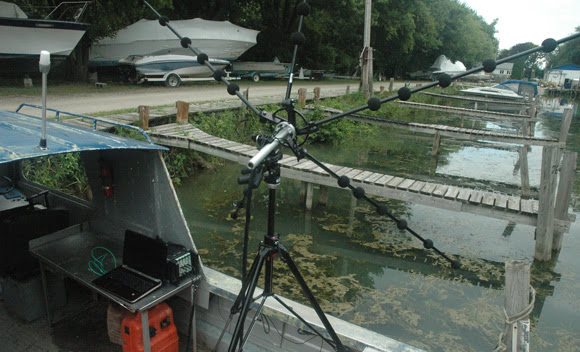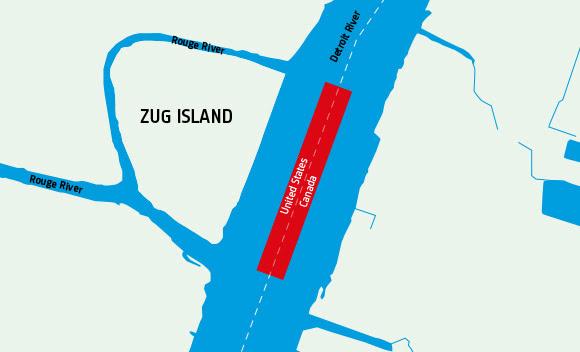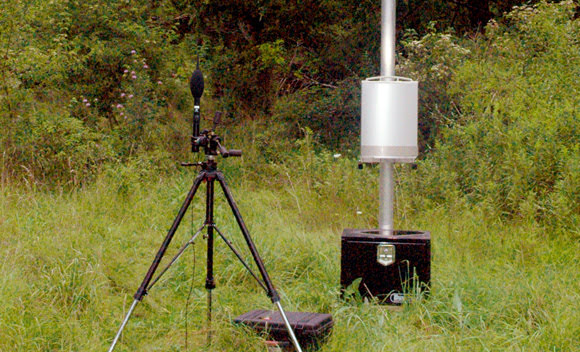Top image: View of the heavily industrialised US Zug Island from the Canadian side of the Detroit River. Locals have described the Windsor Hum as a steady droning sound, much like a diesel truck idling, or a loud boom box. Whatever it is, residents say it is driving them crazy, and that the source must be found. Since the early ‘70s, similar phenomena have been perceived on a worldwide scale. Reports of humming, howling, and rumbling have littered the news in communities including Sydney, Australia; Taos, New Mexico; Leeds, England; and Vancouver, Canada.
In each of these cases, the media have told stories of residents being kept awake at all hours of the night, subject to intermittent humming noise in their own homes and consequently disrupting their lives. With each report comes a wide range of potential sources.
Predictions vary from mechanical sources (submarine activity, generators, worn industrial machines), sonar systems and radio towers, environmental features (rock faults and coastal shifts), to human traits, such as psychological problems and tinnitus.
Whatever the theory is, all those affected demands a resolution be found to alleviate their discomfort.
Zug Island
Island in River Rouge, Michigan
Copyright © Airphoto Jim Wark.
Concerned Citizens of Windsor
The hum in Windsor generated concern among the citizens of this industrial city to the point where the Canadian government agency for natural resources, National Resources Canada, performed a study to find the source.
While the study was able to confirm its existence, it fell short of identifying the cause.
However, through the triangulation of ground vibration measurements, they were able to estimate the origin of the source to Zug Island, a highly industrialized piece of land on the US side of the Detroit River. This is where researchers from the University of Windsor came in since the research arm of the Canadian Federal government did not have the technical resources to investigate further.
The department of Foreign Affairs and International Trade approached the university’s Noise, Vibration, and Harshness, and Sound Quality Research Group to further investigate the source of the elusive rumble. In January 2013, a press conference was held at the University of Windsor to announce federal government funding to locate the source of the ‘Windsor Hum’, in an attempt to protect the quality of life of Windsor’s citizens.
The proposed research was separated into two phases; the first, to validate the existence and characterize the nature of the phenomenon, and the second, upon confirming these characteristics, to use advanced source identification techniques to zoom into specific areas of interest – the only methodology available to the research team without having direct access to Zug Island.
LEARN MORE
MICROPHONE ARRAY SYSTEM
Pentangular microphone array on the university research vessel.
Cloud-based Noise Monitoring
For the first phase, two Brüel & Kjær Noise Monitoring Terminals (NMTs) were deployed.
These units are designed for permanent, mobile, or portable monitoring, where long-term, real-time, unattended outdoor noise measurement is required. The measurement data is recorded and communicated to Noise Sentinel servers, a cloud-based service where continuous noise data is remotely logged, and noise level exceedances are flagged.
In this case, the communications were transmitted using 3G cellular technology, where the data is then available to the researchers through any Web interface. This way, the researchers were able to see, hear, and analyze the measured noise data from the comfort of their laboratory.
The first NMT was a permanent unit installed near the Detroit River shoreline, directly across from Zug Island.
The second NMT was a portable unit that was installed and relocated to different residential areas of the city where reports of the Windsor Hum were made on a regular basis.
Due to the remoteness of the deployment sites, the NMTs were powered using batteries and solar panels, remaining independent of mains power supplies.
Break In The Case: Recording The Windsor Hum
While the first few months of data collection were relatively uneventful, the first real break occurred in early July with a definite recording of the characteristic hum that lasted through most of the night until approximately four in the morning.
LAN-XI DATA ACQUISITION SYSTEM AND LAN-XI NOTAR™
The excitement within the research team was as if they had captured a detailed photograph of the elusive Big Foot creature. Better yet, the hum continued to manifest itself every night for several weeks, usually beginning in the late evening and stopping at about the same time.
To better characterize the acoustic signature of the hum, the Windsor researchers deployed a portable LAN-XI data acquisition system with the LAN-XI Notar™ stand-alone recorder. This setup allowed the researchers to record extremely high-resolution data in the field and then perform post-processing analysis using PULSE Reflex™ back in their laboratory. From this, a very high amplitude, the low-frequency tone was finally identified, which looked and sounded like the varied reports from the community.
Having found and characterized the hum signal, the next step was to locate the actual source. Because the team did not have access to the US land on the island, they again looked to their arsenal of Brüel & Kjær equipment and decided to use a pentangular array to ‘see’ the Windsor hum sound source.
The large, 3.5-meter-diameter array, equipped with 30 microphones, uses acoustic beamforming to visualize acoustic emissions – a result that looks very much like a thermal image, where bright powerful colors represent loud sources of noise and darker colors represent quieter areas of emissions. While the pentangular array is best for sounds above 100 Hz, it still proved to be a useful tool.
Under The Cover of Darkness
The next challenge was to get the pentangaular array in close proximity to the island. For this, the array was mounted in a small boat usually used to research marine life in the North American Great Lakes.
Because the hum was most prominent at night, the researchers also had to take the array near to the US shore in the dark and collect their data at about 100 meters from the shoreline.
This of course raised the suspicions of both the US Coast Guard and Homeland Security, who appeared out of nowhere in the darkness to investigate the researcher’s activities. Nonetheless, the team was able to collect sufficient data and make it back to the Canadian shore without any US jail time.
The pursuit of the Windsor Hum has gained international notoriety from prominent news reports, resulting in inquiries from people affected by similar hums around the world. Both the Canadian government and the University of Windsor researchers, armed with their Brüel & Kjær ‘noise solution toolboxes’, are dedicated to solving this mystery.
A final report is expected to be reviewed by the Canadian government in early 2014 with the hope of alleviating the concerns and discomfort of the community, who only wish for a good night’s rest again.
CONTINUE THE STORY
Since the Canadian government engaged the University of Windsor to investigate its origins, there have been concrete developments in the case of the Windsor Hum.
Solving The Windsor Hum
In January 2013, the government earmarked funding for two research projects to find the Windsor Hum’s origin.
This was followed by an announcement in February 2013 when Professor Colin Novak was chosen to lead a group of fellow scientists and researchers from Windsor and London’s Western University to set up a Brüel & Kjær noise monitoring terminal in a wood in the western part of Windsor.
Noise Monitoring Terminal acting as a virtual ear, tuned to record the Hum 24/7.
Using 3G communications, the team was able to monitor the noise data from the terminal in real-time from anywhere in the world as long as they had access to the web. Other equipment included microphone arrays used to try to pinpoint the origin of the elusive rumble.
Finally, in May 2014, the Canadian government released the two-part report prepared by the research teams at a highly anticipated press gathering next to the Detroit River, overlooking the industrialized side of the Detroit skyline.
The Member of Parliament who led the press announcement stated that while the Western University report was inconclusive, the University of Windsor team was able to confirm scientifically.
Western University Report Findings:
- The Windsor Hum does exist
- The hum emanates from the industrialized Zug Island on the US side of the border.
- The U. S. Steel operations are the likely cause of the hum.
... The Mystery of the Hum Remains
“Unfortunately, we weren’t able to find the smoking gun,” Prof. Colin Novak said following the press event. Novak said he and his partners needed more time and US cooperation to pinpoint the source.
“The study time just wasn’t long enough, especially for a sound like this, one that doesn’t manifest itself on a regular, timed interval. It’s like chasing a ghost.”
Novak said there now needs to be cooperation with all levels of the US and Canadian governments as well with the companies on Zug Island.
“Our job as scientists, while challenging, is not as difficult as the task that the politicians now have in front of them.”






